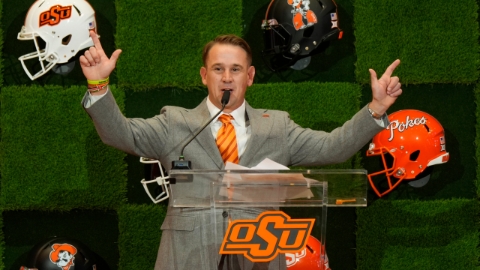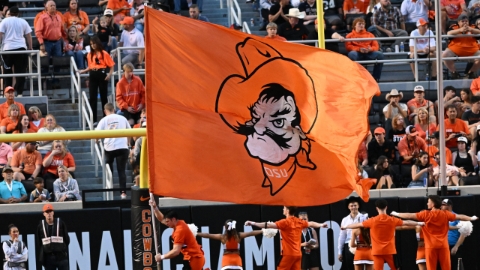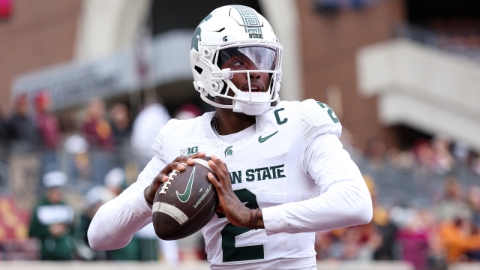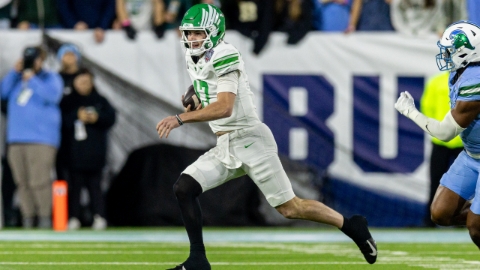I guess I don't get it.... sigh
Shocking! College Football May Not Be Recognizable In a Couple of Years
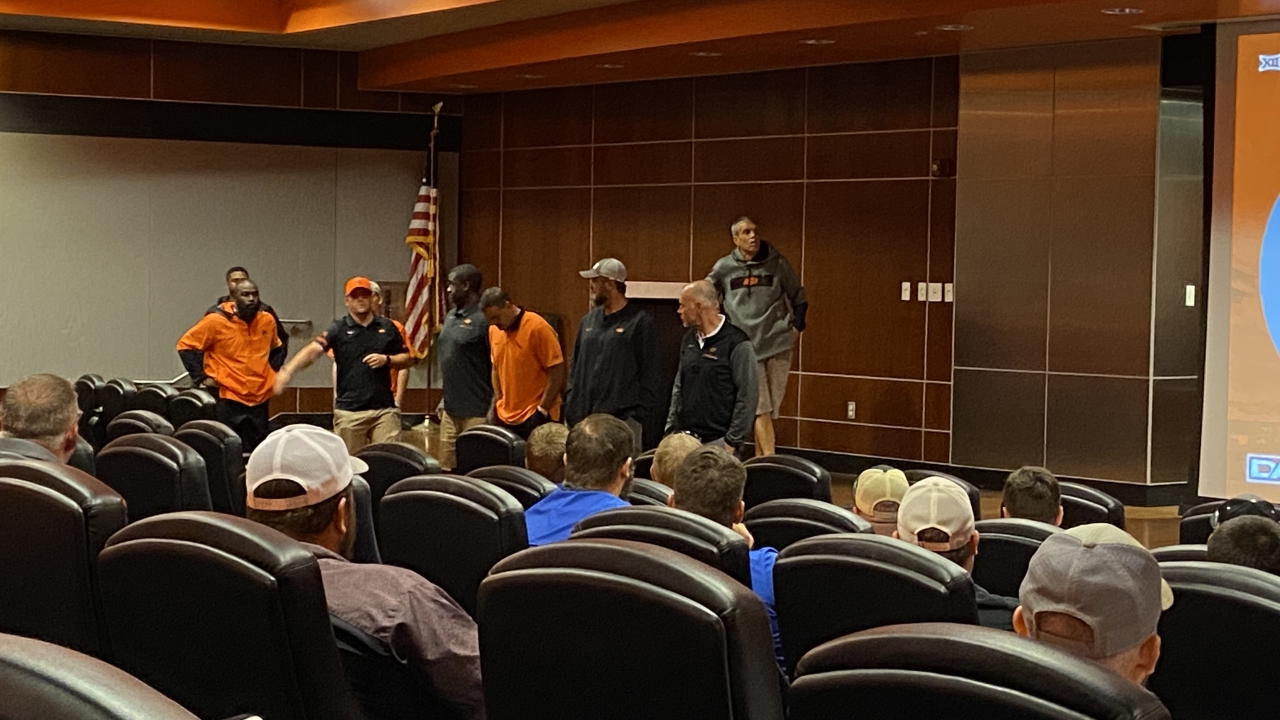
STILLWATER – As we reported on Monday (June 21) we checked in and attended the afternoon session of the first Oklahoma State football coaches clinic held in over two years. Part of the session in the team room was an introduction of the coaching staff and a short presentation by the Cowboys Director of Recruiting Todd Bradford.
Bradford’s information was enlightening and one statement he made to the high school coaches was shocking. There is a lot going on in college athletics and especially college football right now. Recruiting this month has been the first for in-person contact and official visits since early March of 2020. We know the College Football Playoff is in the process of expanding. The Supreme Court just came down Monday with a ruling that opens up schools offering more benefits (educational) to athletes and there could be more coming. You have the transfer portal, which high school coaches noticed has chopped into the scholarships for their players. Finally, there is name, image, and likeness laws on the books and going active on July 1.

“This is so they can start being ready to negotiate the.se deals (in college) because the University is not going to be allowed to do it,” Bradford added.
That’s a bombshell, agents for high school players? To go back and explain, Bradford told the coaches that the NCAA is modeling their NIL process on high school students that are talented enough in dance, music, or some other art form to take money and perform professionally, like a Tulsa-area high school dancer performing in the Tulsa Ballet. That was his exact example. Then that student is still able to take a full scholarship to study dance at Oklahoma State. We know that’s not the same, but the NCAA has had stranger comparisons.
Those gifted students often have agents or at least representatives. Therefore, Bradford feels really talented football players, the five-star and four-star rated recruits will get an agent or representative to help prepare them to the advantage of name, image, and likeness rules.
“The other thing is they are going to make a lot of this money off their social media,” Bradford said. “So, they (athletes) are going to have people help them with their Twitter, TikTok, Instagram, Snapchat and making sure they put the right pictures on there and are talking about the right things on there. For a high profile player he is probably going to be doing this as early as his sophomore year in high school.”
I looked and as Bradford spoke the high school coaches were looking around at each other, some I think in true disbelief at what they were hearing. I know I was shocked at the sound of a high school football player with an agent.
Oklahoma State has been proactive and hopefully there relationship with INFLCR, a firm with a comprehensive plan to help athletes recognize and frame their personal brand so as to be in position to take adavantage of NIL legislation and laws. The Spears School of Business and their pioneering master’s program in entrepreneurship is also on board with Oklahoma State athletics. The coaches were shown this same video.
The Supreme Court ruling on Monday allows for schools to immediately begin offering athletes greater benefits that assist with their academics such as post graduate scholarships, study abroad programs, paid internships, and computers. It also opens the door to other lawsuits to be heard on straight up compensation for their athletic contributions. That will obviously change things.
If the Supreme Court turns college sports into a business versus being a part of the educational process then you will have athletes being taxed for most everything they receive outside of educational assistance. You could see women’s sports and non-revenue sports go by the wayside as Title IX and gender equity will no longer be a viable issue for college sports if they are turned into business.
Before Bradford started in on the NIL situation, he discussed the NCAA Transfer Portal with the coaches. The portal has seen 800 football players enter since Oct. 1, 2020 and Oklahoma State has lost just eight, tied with Baylor for the best (portal) retention in the Big 12. The Cowboys have picked up four players out of the portal. They have gained more than they’ve lost. Although, I think Wake Forest arrival Trey Rucker will be shipping out after his run-in with police.
Bradford showed some more shocking numbers to the coaches over the history of the portal. You may have noticed that former Oklahoma State quarterback Brendan Costello after being inactive in football since the end of the 2019 season finally transferred to USC where he will be a preferred walk-on. That’s a great example of how players get trapped in the portal. Bradford’s numbers show 4,950 players entered in the portal and just 747 have found new schools. Wow.
He went on to explain to the high school coaches that the portal has greatly impacted the opportunities for high school prospects, some of their players.
“What’s happening is it is around 12-to-17% of the players that are going in the portal are finding new homes each month, so if one of your (former) players calls you and says they are thinking about going in the portal they should know they have somewhere to go before they get in the portal,” Bradford explained. “That is difficult to do because schools aren’t allowed to talk to players until they go in their portal.
“The other reason I bring this up is each school only gets 25 initial scholarships a year and the portal players count against that number. So, schools are reserving spots for players in the portal especially if they have an immediate need, like for a left tackle.”

Finally, the College Football Playoff expansion seems to be in high gear. Last week the working group that came up with the new 12-team and four rounds of games (first round, quarterfinals, semifinals, and championship) met with the Division I athletic directors that make up the CFP Management Committee. Today the working group of Bob Bowlsby (Big 12), Greg Sankey (SEC), Jack Swarbrick (AD-Notre Dame), and Craig Thompson (Mountain West) met with the Board of Managers, school presidents representing each conference and Notre Dame.
Mississippi State President Mark Keenum is the chairperson of that group, the Board of Managers for the CFP.
"Having heard the presentation made today by the working group, along with the management committee that joined us for today's meeting, the board has authorized the management committee to begin a summer review phase that will engage other important voices in this matter,” Keenum released in a statement. “These include many people on our campuses, such as student-athletes, athletics directors, faculty athletics representatives, coaches, and university presidents and chancellors. Their opinions are important, and we want to hear them.
"We have relationships with the bowls and a broadcast partner with whom we will want to consult to explore the feasibility of the 12-team proposal,” he added of the two relationships that would be critical in moving a change in format along more rapidly.
"This too will happen during this summer study period. Having given the management committee the charge to look into expansion, it is our duty to take their good work and ascertain whether it is feasible based on the feedback we receive. I caution observers of our process not to rush to conclusions about what this board may decide,” Keenum’s statement concluded.
NIL, Supreme Court decision, and the loss of revenue across college athletics due to COVID-19 makes this a great time for a revenue enhancement and that sure looks like what an expanded College Football Playoff could do.
